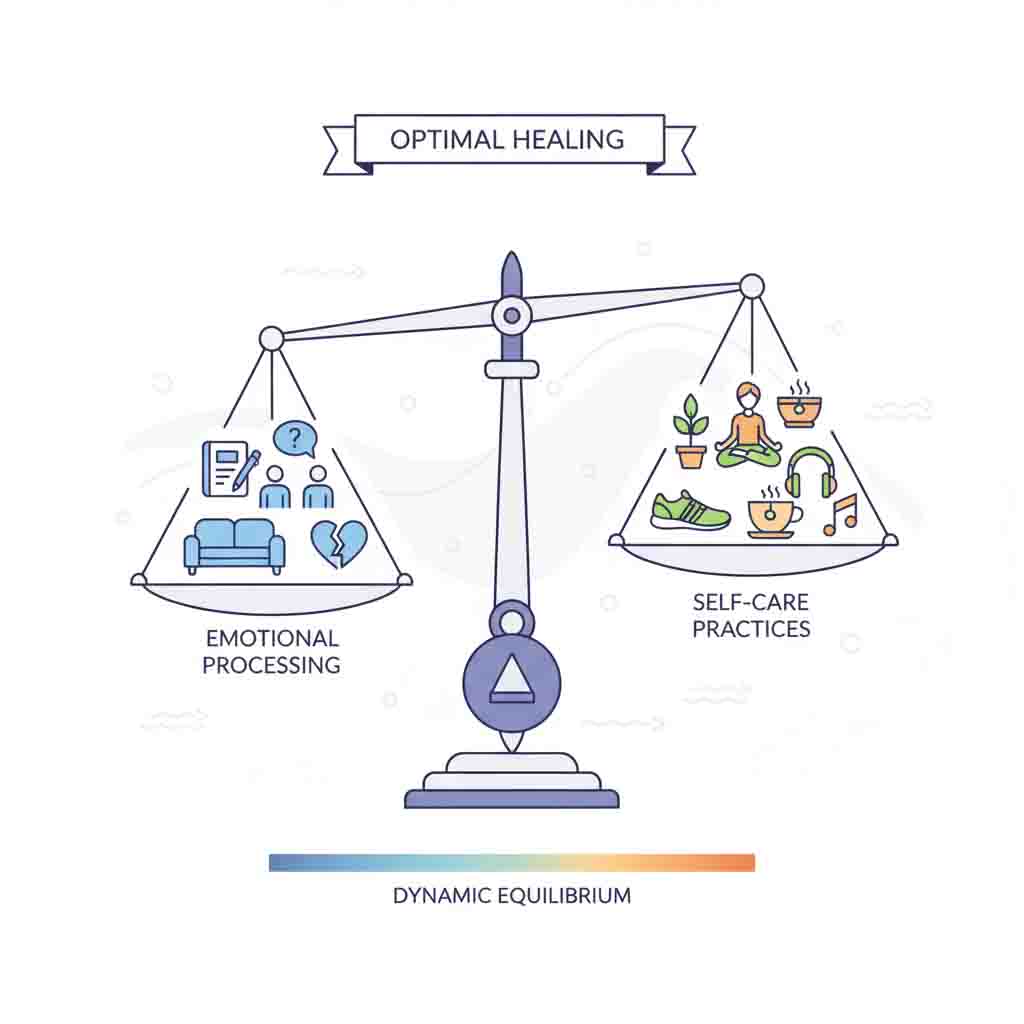Table of Contents
-
Defining Emotional Healing
1. Defining Emotional Healing
Emotional healing represents a proactive journey of addressing and resolving past emotional injuries to restore psychological well-being. It’s not about erasing memories, but rather transforming your relationship with painful experiences to reduce their negative impact on present functioning.
The healing process enables individuals to integrate difficult experiences into their life narrative without being controlled by them. Research from the American Psychological Association demonstrates that properly processed emotional wounds can actually contribute to post-traumatic growth, where individuals develop greater resilience and appreciation for life.
Q: How is emotional healing different from simply forgetting painful experiences?
A: Healing involves conscious processing and integration of experiences, while forgetting is avoidance. True healing allows you to remember without re-experiencing the original pain intensity.
2. The Science of Emotional Recovery
Neuroscience reveals that emotional healing involves rewiring neural pathways associated with painful memories. The brain’s neuroplasticity allows for creating new connections that support healthier responses to emotional triggers.
The polyvagal theory, developed by Dr. Stephen Porges, explains how our nervous system regulates responses to threat and safety. Healing involves returning the nervous system to a regulated state where social engagement and connection become possible again. Studies show that successful emotional processing increases activity in the prefrontal cortex, enhancing emotional regulation.
Q: Can emotional healing actually change brain structure?
A: Yes, fMRI studies confirm that successful therapeutic processes can strengthen neural pathways in regions responsible for emotional regulation while reducing hyperactivity in threat-response areas.
3. Core Principles of Effective Healing
Safety First
Healing requires establishing both external and internal safety. This means creating environments and relationships where vulnerability is protected, and developing self-regulation skills to manage emotional discomfort.
Process Over Performance
Focus on engagement with the healing process rather than achieving specific outcomes. Healing follows its own timeline and cannot be rushed according to arbitrary deadlines.
Integration, Not Elimination
The goal is integrating experiences into your life story, not removing them. This means acknowledging what happened while reducing its power to dictate current behavior and emotional states.
Mind-Body Connection
Emotional wounds manifest physically. Effective healing addresses somatic aspects through techniques like breathwork, mindful movement, and body awareness practices.
Q: How long does genuine emotional healing typically take?
A: Timelines vary significantly based on the nature of the wound, individual history, and consistency of healing practices. Sustainable healing generally occurs in phases over months or years, not days or weeks.
4. The Healing Process: Step by Step
Assessment Phase (Weeks 1-2)
Begin by identifying specific emotional wounds and their current impact. Map triggering situations, physical sensations associated with distress, and patterns of emotional avoidance. Establish baseline measurements of symptoms and functioning.
Stabilization Phase (Weeks 3-6)
Develop emotional regulation skills before processing core wounds. Practice grounding techniques, establish self-care routines, and create a support system. This phase builds the foundation necessary for deeper work.
Processing Phase (Weeks 7-12)
Gradually approach difficult emotions and memories in manageable doses. Use journaling, therapeutic techniques, or guided work to reframe and reorganize emotional responses to past events.
Integration Phase (Months 4-6)
Apply new perspectives and coping strategies to daily life. Test emerging emotional resilience in increasingly challenging situations while maintaining support systems.
Growth Phase (Ongoing)
Shift focus from wound management to positive development. Identify new meaning derived from healing journey and establish practices that support continued emotional well-being.
Q: What if I become overwhelmed during the processing phase?
A: Return to stabilization techniques until you feel regulated. Healing should occur within your “window of tolerance” – the zone where you can process difficult material without becoming overwhelmed.

5. Common Healing Mistakes and Solutions
Rushing the Process
Many people attempt to accelerate healing through intensive exposure to triggering material. Solution: Honor your natural pacing, recognizing that gradual, consistent progress creates more sustainable outcomes.
Isolating During Difficult Periods
Withdrawing from support when feeling worst. Solution: Pre-commit to maintaining social connection especially when you feel inclined to isolate.
Over-Identifying with the Wound
Building identity around being “wounded.” Solution: Practice describing experiences as “things that happened to you” rather than “who you are.”
Neglecting Physical Health
Underestimating sleep, nutrition, and movement’s impact on emotional recovery. Solution: Track basic self-care as foundational to healing work.
Q: How can I distinguish between normal healing discomfort and re-traumatization?
A: Normal healing discomfort feels manageable and leads to incremental progress, while re-traumatization involves feeling overwhelmed, helpless, or regressing in functioning.
6. Maintaining Emotional Health
Sustainable healing requires ongoing practices that support emotional resilience. Regular self-check-ins, maintaining healthy boundaries, and continuing skills practice prevent backsliding and build upon healing gains.
Research from the University of Pennsylvania demonstrates that individuals who maintain healing practices for at least six months after initial recovery show significantly lower relapse rates. These practices include mindfulness, continued social connection, and routine self-reflection.
Remember that emotional health isn’t a destination but an ongoing process of adjustment and growth. Life’s inevitable challenges become opportunities to apply and strengthen your healing rather than threats to your progress.
Q: How do I know when I’ve “completed” the healing process?
A: Healing completion isn’t about never feeling pain again, but rather about having developed sufficient resilience and tools to navigate future challenges effectively without returning to previous dysfunctional patterns.



